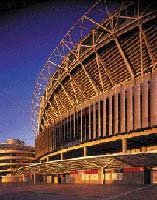
Wish we’d done it ourselves! It’s been on the list, but we haven’t gotten to it yet. Now the U.S. Department of Energy (DOE) has given us a platform to catalog and learn about high-performance building projects around the world. The High Performance Buildings Database has been seeded with about 25 projects – most of them well known – and you can add your own. You can enter a project of any size, from any country, from a campus to a home. You can search by building type, location, size, keyword, and many other parameters. There is lots of flexibility in the depth of information you enter and in the project itself: it can simply have several notable green features or be a certified LEED project. A convenient menu on the left enables you to quickly look through the project’s features: finance, land use, site and water, energy, materials, indoor environment, images, ratings and awards.
One of the profiles, Stadium Australia, served as the main arena for the Sydney 2000 Olympics. The design team employed the most comprehensive energy modeling to date for a stadium project. The building systems and materials chosen optimized energy use – passive ventilation and natural daylighting were incorporated as major features. The profile also details other features that were an important part of the design: cogeneration, water conservation, and advanced waste management techniques.
hpbdata@buildingGreen.com
[sorry this link is no longer available]
In other DOE news, the agency just announced it will award $2 million to 22 states to help them update and implement their building energy codes. To date, DOE’s investments in building energy codes have improved the energy efficiency of nearly three billion square feet of new commercial floor space and nearly four million households, saving consumers an estimated $4.2 billion. For every dollar spent, DOE’s Building Energy Codes Program yields more than $105 in annual energy savings.
The awards will be made to state energy offices and state code authorities by the end of September. The funds are being provided through DOE’s State Energy Program.
FROM EREN Network News, a SustainableBusiness.com Content Partner
High Performance Buildings On Your Desktop

Published on: June 14, 2002
(Visited 44 times, 7 visits today)